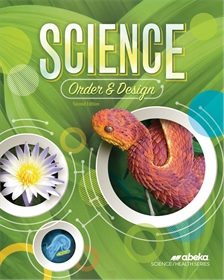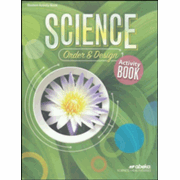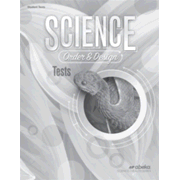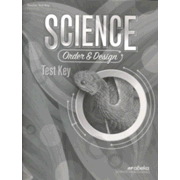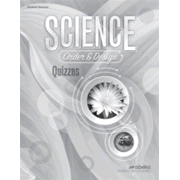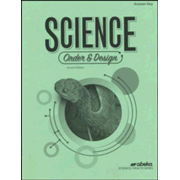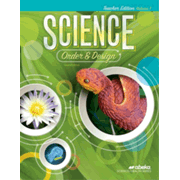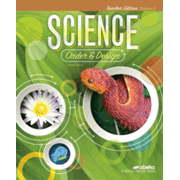Illustrations, hands-on experiments, and a colorful format should make Abeka's Science: Order & Design appealing to seventh graders. The text often addresses students directly such as when it says, “As you eat and digest food, your digestive system acts mechanically and chemically upon the food to break it down into molecules that can be absorbed into the blood” (p. 85). While this approach is more often used with younger children, it still helps junior high students relate to the information.
Lessons are presented in 13 chapters that cover topics such as scientific classification, the scientific method, plants, the human body, health, creation science, evolution, mammals, birds, fish, reptiles, amphibians, insects, invertebrates, using a microscope, trees, forestry, ecology, and ecosystems.
Chapters are divided into sections, with each section focused on a narrower topic. At the end of each section are “Section Review" questions. These include four or more comprehension questions and, sometimes, one or more “Thought Provoker” questions. The thought questions sometimes just require lengthier answers, but some require students to synthesize the information they have read to come up with answers, such as with the question on page 45: “Would a coconut be likely to germinate on the shores of Alaska? Why or why not?”
At the end of each chapter is a Chapter Review that helps prepare students for the chapter test. They are given long lists of words and terms to define and phrases to identify (e.g., the eleven systems of the human body or the parts of a tooth on page 115). The extensive glossary at the back of the book should be helpful for this. Questions in the Chapter Review are presented under the headings of Explain and Apply, but the questions don’t seem distinctly different in the two sections, and students are expected to write out the answers to both types of questions. The most thought-provoking questions seem to be in the fifth chapter which is about creation and evolution. It presents a strongly creationist position and supports belief in a young earth. It has Chapter Review questions such as “Explain how specified complexity proves the existence of an intelligent Designer” and “Contrast the assumptions of materialism with what the Bible teaches” (p. 195).
You can purchase a textbook answer key that has only the answers for both section and chapter questions. Alternatively, you can purchase the two-volume teacher’s edition that has answer keys for the textbook along with teaching information, lesson plans, and reduced images of the student pages. The teacher’s edition alerts you to the activities that will be done for each lesson, but they still require you to go to the activities themselves (in either the textbook or teacher's edition) to see what equipment and resources will be required. (I wish it had a list of required resources for the activities at the beginning of each chapter or else in one place for the entire course.) The teacher’s edition seems most useful as an answer key and for student assignments.
There are separate quiz and test books for this course, and there are separate answer keys for the quiz book and the test book.
Hands-On Activities and Call-Out Boxes
Almost every chapter has at least one hands-on activity. Some that are presented under the headings “Backyard Scientist” and “Nature Explorer” are outdoor observations or activities. “Science Investigation” and “Check It Out” are experiments, dissections, and other indoor activities. These generally can be done with household items, but you will sometimes need some other items such as a spring scale, a pocket or field microscope, and an insect collecting net.
There are a number of other special call-out boxes throughout the text. “Math Connections” show how math is used in specific scientific applications. “A Closer Look” features in-depth articles on topics such as “Trees in the Desert” and “Thinking with Models.” Religious themes sometimes show up in "A Closer Look," and “Creation Clip” articles show how creation continually provides evidence of a creator.
Activity Book and STEM Project
The Science: Order & Design Activity Book has activity sheets for each chapter and instructions for a STEM (Science, Technology, Engineering, Math) project. The activity sheets include multiple-choice questions, crossword puzzles, word-search puzzles, images to label, columns to match, and fill-in-the-blanks exercises with word banks.
The STEM project has students create a design, develop an application, or investigate a STEM-related topic. Instructions are in both the student and teacher editions of the Activity Book. Students are supposed to create a logbook and write a paper about the project. It seems to me that the STEM project could be optional since the course has plenty of material without it. However, projects are especially effective ways to develop real-world understanding and applications for what students are learning. I would encourage you to try to have students complete one. Note that Abeka's eighth-grade science course includes a similar STEM project, so you might choose to have students complete one in only one year or the other if the student has trouble completing one each year.
Summary
This course should appeal especially to parents who want a science curriculum that supports a creationist point of view. I like the wide variety of activities and the fact that they should be fairly easy to use in homeschool settings.





